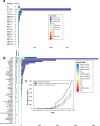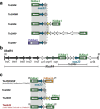Emergence, molecular mechanisms and global spread of carbapenem-resistant Acinetobacter baumannii
- PMID: 31599224
- PMCID: PMC6861865
- DOI: 10.1099/mgen.0.000306
Emergence, molecular mechanisms and global spread of carbapenem-resistant Acinetobacter baumannii
Abstract
Acinetobacter baumannii is a nosocomial pathogen that has emerged as a global threat because of high levels of resistance to many antibiotics, particularly those considered to be last-resort antibiotics, such as carbapenems. Although alterations in the efflux pump and outer membrane proteins can cause carbapenem resistance, the main mechanism is the acquisition of carbapenem-hydrolyzing oxacillinase-encoding genes. Of these, oxa23 is by far the most widespread in most countries, while oxa24 and oxa58 appear to be dominant in specific regions. Historically, much of the global spread of carbapenem resistance has been due to the dissemination of two major clones, known as global clones 1 and 2, although new lineages are now common in some parts of the world. The analysis of all publicly available genome sequences performed here indicates that ST2, ST1, ST79 and ST25 account for over 71 % of all genomes sequenced to date, with ST2 by far the most dominant type and oxa23 the most widespread carbapenem resistance determinant globally, regardless of clonal type. Whilst this highlights the global spread of ST1 and ST2, and the dominance of oxa23 in both clones, it could also be a result of preferential selection of carbapenem-resistant strains, which mainly belong to the two major clones. Furthermore, ~70 % of the sequenced strains have been isolated from five countries, namely the USA, PR China, Australia, Thailand and Pakistan, with only a limited number from other countries. These genomes are a vital resource, but it is currently difficult to draw an accurate global picture of this important superbug, highlighting the need for more comprehensive genome sequence data and genomic analysis.
Keywords: AbaR4 and plasmid; Acinetobacter baumannii; GC1; GC2; Tn2006; Tn2008; Tn2009; carbapenem resistance; global clones; oxa23; oxa235; oxa24; oxa58.
Conflict of interest statement
The authors declare that there are no conflicts of interest.
Figures



Similar articles
-
Accumulation of Antibiotic Resistance Genes in Carbapenem-Resistant Acinetobacter baumannii Isolates Belonging to Lineage 2, Global Clone 1, from Outbreaks in 2012-2013 at a Tehran Burns Hospital.mSphere. 2020 Apr 8;5(2):e00164-20. doi: 10.1128/mSphere.00164-20. mSphere. 2020. PMID: 32269158 Free PMC article.
-
Genomic Analysis of Carbapenem-Resistant Acinetobacter baumannii Strains Recovered from Chilean Hospitals Reveals Lineages Specific to South America and Multiple Routes for Acquisition of Antibiotic Resistance Genes.Microbiol Spectr. 2022 Oct 26;10(5):e0246322. doi: 10.1128/spectrum.02463-22. Epub 2022 Sep 26. Microbiol Spectr. 2022. PMID: 36154439 Free PMC article.
-
Variants of Tn6924, a Novel Tn7 Family Transposon Carrying the blaNDM Metallo-β-Lactamase and 14 Copies of the aphA6 Amikacin Resistance Genes Found in Acinetobacter baumannii.Microbiol Spectr. 2022 Feb 23;10(1):e0174521. doi: 10.1128/spectrum.01745-21. Epub 2022 Jan 12. Microbiol Spectr. 2022. PMID: 35019774 Free PMC article.
-
Carbapenem resistance in Acinetobacter baumannii: the molecular epidemic features of an emerging problem in health care facilities.J Infect Dev Ctries. 2009 Jun 1;3(5):335-41. doi: 10.3855/jidc.240. J Infect Dev Ctries. 2009. PMID: 19759502 Review.
-
Mobile genetic elements related to carbapenem resistance in Acinetobacter baumannii.Braz J Microbiol. 2016 Oct-Dec;47(4):785-792. doi: 10.1016/j.bjm.2016.06.005. Epub 2016 Jul 4. Braz J Microbiol. 2016. PMID: 27522927 Free PMC article. Review.
Cited by
-
Metformin reverse minocycline to inhibit minocycline-resistant Acinetobacter baumannii by destroy the outer membrane and enhance membrane potential in vitro.BMC Microbiol. 2022 Sep 12;22(1):215. doi: 10.1186/s12866-022-02629-4. BMC Microbiol. 2022. PMID: 36089583 Free PMC article.
-
Lipocalin-2 is an essential component of the innate immune response to Acinetobacter baumannii infection.PLoS Pathog. 2022 Sep 2;18(9):e1010809. doi: 10.1371/journal.ppat.1010809. eCollection 2022 Sep. PLoS Pathog. 2022. PMID: 36054235 Free PMC article.
-
Preferential Selection of Low-Frequency, Lipopolysaccharide-Modified, Colistin-Resistant Mutants with a Combination of Antimicrobials in Acinetobacter baumannii.Microbiol Spectr. 2022 Oct 26;10(5):e0192822. doi: 10.1128/spectrum.01928-22. Epub 2022 Sep 29. Microbiol Spectr. 2022. PMID: 36173297 Free PMC article.
-
Plasmid-Mediated Spread of Carbapenem Resistance in Enterobacterales: A Three-Year Genome-Based Survey.Antibiotics (Basel). 2024 Jul 23;13(8):682. doi: 10.3390/antibiotics13080682. Antibiotics (Basel). 2024. PMID: 39199982 Free PMC article.
-
Virulence potential of multidrug-resistant Acinetobacter baumannii isolates from COVID-19 patients on mechanical ventilation: The first report from Serbia.Front Microbiol. 2023 Feb 6;14:1094184. doi: 10.3389/fmicb.2023.1094184. eCollection 2023. Front Microbiol. 2023. PMID: 36825087 Free PMC article.
References
Publication types
MeSH terms
Substances
LinkOut - more resources
Full Text Sources
Research Materials

